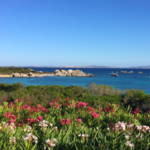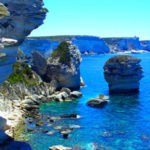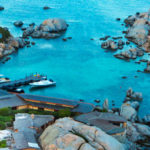“The Garden of Wonders…”

The gardens surround the backside of the Palazzo Pitti, to which they are attached, and extend from there with such lavishness and spectacular perspectives that one is almost led to regard them as the perfect finishing touch completing the improvement works that the palace underwent after Eleonora of Toledo, wife of the Grand Duke Cosimo I de’ Medici, bought in 1549 from Luca Pitti, its previous owner.
Covering a surface of about 45.0000 smq on the hill of Boboli, the gardens are connected, on the one hand, to the legendary “Vasarian Corridor” running between the Palazzo Vecchio and Palazzo Pitti and, on the other, to the Forte del Belvedere, a fortress built to protect the Medici family. Cosimo spared no pains to ensure that the beauty of the gardens reflected that of his wife Eleonora: over the course of time, 5 great architects were entrusted with the project. Niccolò Tribolo laid out the initial design but died just one year after the beginning of works. However, his design, which incorporated elements inspired by humanist philosophy, remained a point of reference for his successors, namely, in chronological order, Ammannati, Buontalenti and Giulio and Alfonso Parigi.

One cannot confine oneself to a brief historical background or a list of artworks when trying to grasp the enchanting complexity of the Boboli Gardens, and we strongly recommend that you visit them in person. All the same, we will not fail in our duty of hospitality and will try to offer at least a general overview that may encourage you to go and explore this truly unique place, which became a UNESCO World Heritage Site in 2013.
First of all, we should say that the Boboli Gardens have four access points: the courtyard built by Ammannati, which is just behind Palazzo Pitti and features a Fontana del Carciofo (literally, fountain of the artichoke); the Forte Belvedere; Via Romana; and Piazzale di Porta Romana.
In addition to buying an entry ticket, we suggest contacting a touristic guide who may lead you through the museums hosted in the garden, which include the Museo degli argenti, Galleria del costume, Museo delle Porcellane and giardino Baldini.
If you begin your visit along the axis that starts from the centre of the back façade of the palazzo, you will see the Amphitheater designed by Tribolo and later on enriched by Giulio and Alfonso Parigi with tiers, marble statues, aedicules and terracotta urns. The Egyptian Obelisk at the centre of the amphitheatre, which dates back to 1500 B.C, is the only obelisk in Tuscany and was added in 1790. The single-block granite basin was probably taken from the Terme Alessandrine in Rome and was added in 1840.

At the very top you will find the “Statua dell’Abbondanza” (statue of Plenty), begun by Giambologna in 1608 and completed by Pietro Tacca, which portrays and commemorates Joanna of Austria, wife of Francesco I de’ Medici, who died due to an accident at the Palazzo when she was still very young, in 1578. From this elevated spot you can see the defence walls of the Forte del Belvedere, which line the garden.
Taking a path on the left you will reach a Rococo-style pavilion, now a cosy bar, topped by a glazed dome by Zanobi del Rosso (1776) and facing a sloping lawn in the midst of which lies the “Fountain of Ganymede”.
If you go back to the central axis you followed at the beginning, high up on the top you will see one of the most interesting highlights of our tour: the “Giardino del Cavaliere” (the knight’s garden), which can be accessed through a stairway and is surrounded by walls that were meant to keep it hidden. Its name probably derives from military jargon: at the time it was built, it “rode” the rampart of the fortifications created by Michelangelo in 1529. At the centre of the garden, which features rare species of roses and dahlias and is bordered by box hedges cut into geometric shapes, stands a fountain with a central marble cherub spouting water. This ornamental work is called “Fontana delle Scimmie”, probably because of the three little bronze monkeys at its base.

The façade is surmounted by a tympanum and flanked by two pilasters. These frame a swelling surface that skilfully reproduces spongy rocks and, therefore, is a prelude to the inside of the small grotto, whose walls are covered with elements that create the illusion of ‘cave’ with stalactites, whereas the ceiling is traversed by spongy stones that frame a number of “grottesche” (a sort of graffiti popular in the 16th century) by Baciacca and Poccetti.

After mentioning Buontalenti, we cannot but devote our concluding paragraphs to the fanciful art and extraordinary style of this multi-faceted genius, without discussing other highlights or landscape features of the Boboli Gardens which can be fully appreciated only by going there in person. The reproduction of natural caves was not unusual in the Renaissance: artificial grottos were built in the gardens of large villas and enriched with architectural details, sculptures, and water effects
Against this backdrop, however, Buontalenti’s Grande Grotta, with its bold and original combination of architectural, sculptural and pictorial elements, truly stands out as a mannerist masterpiece.
The famous grotto is located at the end of the Vasari’s corridor and was built between 1583 and 1593. The portico features a large entrance flanked by two niches, one containing a statue of Ceres and the other a statue of Apollo.
Two columns stand amidst the entrance, which is surmounted by a lintel and a tympanum decorated with stalagmites made of apparently spongy material. In the upper part of the portico, right above the open lunette, two bas-relief female figures lie on either side of the Medici coat of arms, while on the edges of the portico there are two symmetrical mosaic frames, made with coloured pebbles, that complete the decoration with stuccos depicting festoons and sea ibexes.
Inside, the grotto is divided into three adjoining chambers.
The first and bigger one has a series of decorations that produce wonder in the viewer. Here, the aim is to represent the alchemical theories endorsed by Francesco I de ‘Medici, who commissioned the grotto: in other words, the metamorphosis of matter from chaos (the rocky walls at the end of the chamber, with their raw, shapeless materials) to order and harmony (the zoomorphic and anthropomorphic figures that move away from the end of the chamber). At the four corners of the chamber there are copies of Michelangelo’s “Prigioni” .

In the second chamber, also featuring ‘rocky’ walls, there are two fake niches with portrayals of Juno and Minerva surmounted by a tympanum, while in the centre there is a group of marble statues Vincenzo de’ Rossi depicting Paris and Helen (1560).
The third and last chamber is also a grotto, but here there is a sky with flying birds and a the lovely Bathing Venus by Giambologna, a statue depicting Venus surrounded by four satyrs that spout water.









